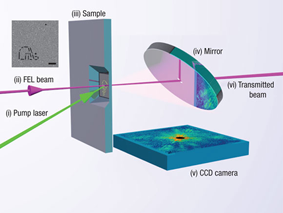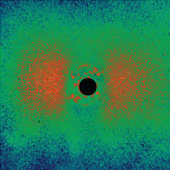Sample evolution revealed by coherent X-ray diffraction (after 40 ps). (for details see zoom: measured single-shot diffraction patterns at 25 ps (a ), corresponding to the object before the laser pulse, and at 10 ps (b), 15 ps (c), 20 ps (d) 40 ps (e) and 140 ps ( f ) after the laser pulse.) (Courtesy: Nature Photonics)
Scientists from Lawerence Livermore Nat. Lab. (USA), Standord (USA), Uppsala University (Sweden), University of Duisburg-Essen, University of Oxford, University of California (USA), CFEL and HASYLAB/DESY have measured time-series snapshots of a solid as it evolves on the ultra-fast timescale at FLASH.
Structures imprinted on a special window were excited with an optical laser. The subsequent laser ablation, was imaged with a spatial resolution of 50 nm and a temporal resolution of 10 ps. By combining this resolution with the nanoscale imaging capabilities of a coherent diffraction imaging geometry and a synchronous reaction trigger, H. Chapman and his colleagues were able to capture single-shot images of nanoscale dynamics on the timescale of individual atomic motion. The Experiments were carried out at beamline BL2 at FLASH at DESY using 13.5 nm light .
This technique could be extended to spatial resolutions of a few nanometres and temporal resolutions of a few tens of femtoseconds, which will open the door to a new regime of time-resolved experiments. The transient nanoscale dynamics of materials on femtosecond to picosecond timescales is of great interest in the study of condensed phase dynamics such as crack formation, phase separation and nucleation, and rapid fluctuations in the liquid state or in biologically relevant environments.
The results were published online in Nature Photonics (22 June 2008) .
(from: ...Paper and press release)

A visible light laser beam (i) is focused onto the sample (iii) and acts as the excitation pulse. A soft X-ray pulse (ii) is focused to the same location but at a continuously variable delay. The X-ray pulse diffracts from the sample, carrying information about the transient sample structure to the CCD detector (v) in the form of a coherent diffraction pattern. (Courtesy: LLNL (USA))
| Further Links |
|






